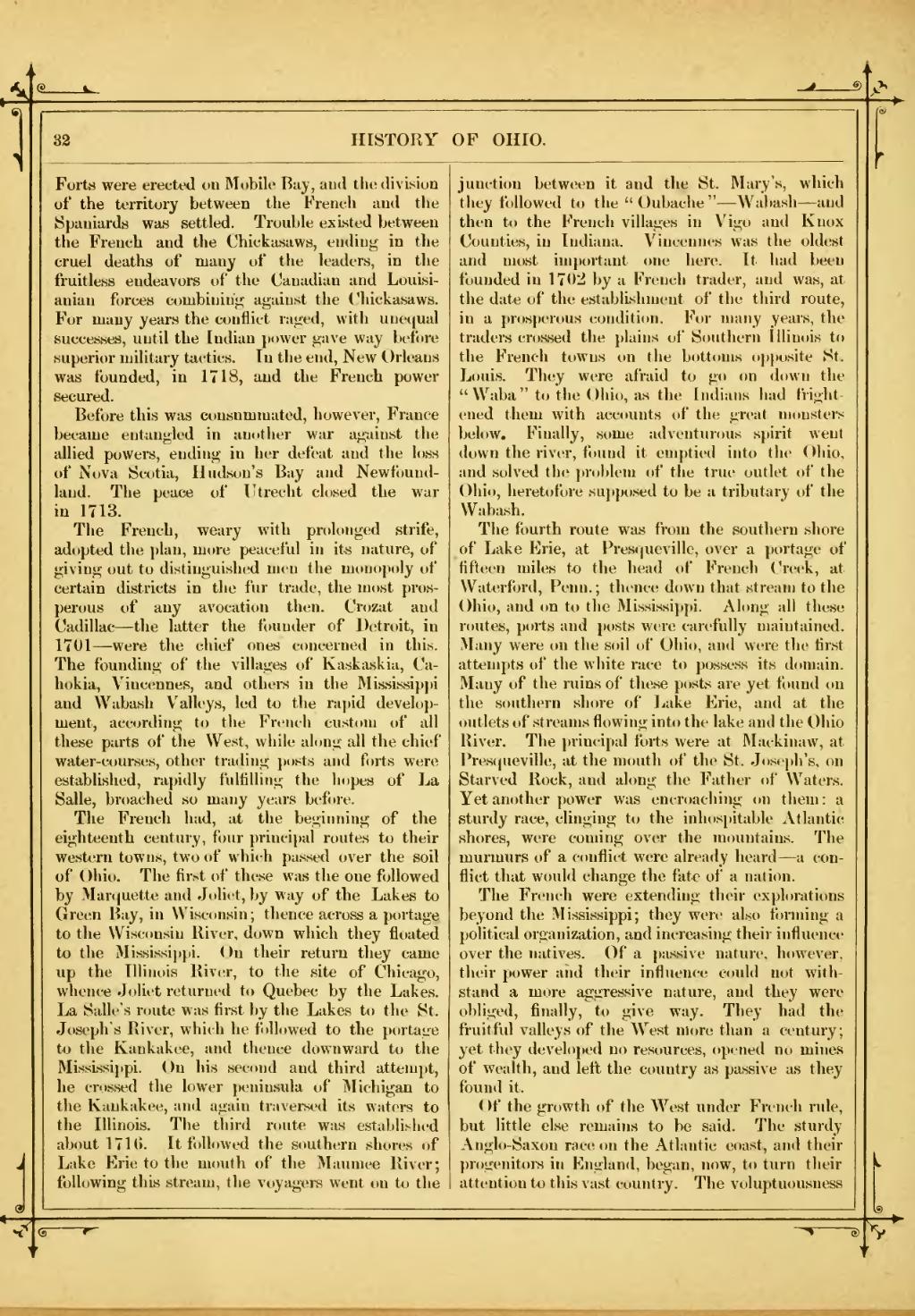Forts were erected on Mobile Bay, and the division
of the territory between the French and the
Spaniards was settled. Trouble existed between the French and the Chickasaws, ending in the cruel deaths of many of the leaders, in the fruitless endeavors of the Canadian and Louisianian forces combining against the Chickasaws.
For many years the conflict raged, with unequal successes, until the Indian power gave way before superior military tactics. In the end. New Orleans was founded, in 1718, and the French power secured.
Before this was consummated, however, France became entangled in another war against the allied powers, ending in her defeat and the loss of Nova Scotia, Hudson's Bay and Newfoundland. The peace of Utrecht closed the war in 1713.
The French, weary with prolonged strife, adopted the plan, more peaceful in its nature, of giving out to distinguished men the monopoly of certain districts in the fur trade, the most prosperous of any avocation then. Crozat and Cadillac — the latter the founder of Detroit, in 1701 — were the chief ones concerned in this. The founding of the villages of Kaskaskia, Cahokia, Vincennes, and others in the Mississippi and Wabash Valleys, led to the rapid development, according to the French custom of all these parts of the West, while along all the chief water-courses, other trading posts and forts were established, rapidly fulfilling the hopes of La Salle, broached so many years before.
The French had, at the beginning of the eighteenth century, four principal routes to their western towns, two of which passed over the soil of Ohio. The first of these was the one followed by Marquette and Joliet, by way of the Lakes to Green Bay, in Wisconsin; thence across a portage to the Wisconsin River, down which they floated to the Mississippi. On their return they came up the Illinois River, to the site of Chicago, whence Joliet returned to Quebec by the Lakes. La Salle's route was first by the Lakes to the St. Joseph's River, which he followed to the portage to the Kankakee, and thence downward to the Mississippi. On his second and third attempt, he crossed the lower peninsula of Michigan to the Kankakee, and again traversed its waters to the Illinois. The third route was established about 1716. It followed the southern shores of Lake Erie to the mouth of the Maumee River; following this stream, the voyagers went on to the junction between it and the St. Mary's, which they followed to the "Oubache " — Wabash — and then to the French villages in Vigo and Knox Counties, in Indiana. Vincennes was the oldest and most important one here. It had been founded in 1702 by a French trader, and was, at the date of the establishment of the third route, in a prosperous condition. For many years, the traders crossed the plains of Southern Illinois to the French towns on the bottoms opposite St. Louis. They were afraid to go on down the "Waba " to the Ohio, as the Indians had frightened them with accounts of the great monsters below. Finally, some adventurous spirit went down the river, found it emptied into the Ohio, and solved the problem of the true outlet of the Ohio, heretofore supposed to be a tributary of the Wabash.
The fourth route was from the southern shore of Lake Erie, at Presqueville, over a portage of fifteen miles to the head of French Creek, at Waterford, Penn.; thence down that stream to the Ohio, and on to the Mississippi. Along all these routes, ports and posts were carefully maintained. Many were on the soil of Ohio, and were the first attempts of the white race to possess its domain. Many of the ruins of these posts are yet found on the southern shore of Lake Erie, and at the outlets of streams flowing into the lake and the Ohio River. The principal forts were at Mackinaw, at Presqueville, at the mouth of the St. Joseph's, on Starved Rock, and along the Father of Waters. Yet another power was encroaching on them: a sturdy race, clinging to the inhospitable Atlantic shores, were coming over the mountains. The murmurs of a conflict were already heard — a conflict that would change the fate of a nation.
The French were extending their explorations beyond the Mississippi; they were also forming a political organization, and increasing their influence over the natives. Of a passive nature, however, their power and their influence could not withstand a more aggressive nature, and they were obliged, finally, to give way. They had the fruitful valleys of the West more than a century; yet they developed no resources, opened no mines of wealth, and left the country as passive as they found it.
Of the growth of the West under French rule, but little else remains to be said. The sturdy Anglo-Saxon race on the Atlantic coast, and their progenitors in England, began, now, to turn their attention to this vast country. The voluptuousness
